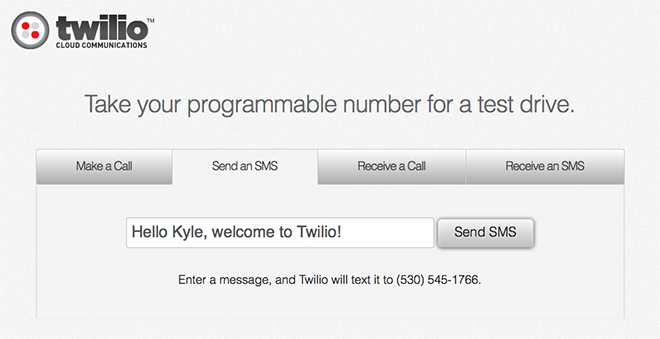Twilio Quickstart¶
The next section will take you on a whirlwind tour of the features of the Twilio API. You’ll learn how to make phones ring, send text messages, and record voice messages.
Make sure you’ve completed the Initial Setup section before continuing.
Create a Twilio Account¶
First, sign up for a free Twilio account. You won’t need a credit card, but you will need a phone number to prove you aren’t a robot. Once you’ve signed up, you’ll have your own Twilio phone number. We’ll use this number for the rest of the workshop.
After you’ve created your account and verified your phone number, you should end up at a screen that looks like this.

This is your first chance to test out what Twilio can do. Send yourself a text message and receive a call. Congratulations, you’ve used Twilio for the first time!
However, how would you do this from your own code? I’m glad you asked.
Hello World - SMS¶
Let’s send a text message using Python and the Twilio REST API. Open the send_sms.py file in your text editor. First, replace the dummy account credentials with those of your own. Your account credentials can be found on the top of your Twilio account dashboard.
from twilio.rest import TwilioRestClient
TWILIO_ACCOUNT_SID = ''
TWILIO_AUTH_TOKEN = ''
On the next line, set TO_NUMBER to the number you used to sign up with Twilio. During your free trial, you’re only allowed to make calls and send messages to numbers you’ve verified.
Set FROM_NUMBER to your new Twilio number. If you can’t remember it, check the numbers section of your account dashboard.
Pick any message less than 140 characters to serve as the body.
TO_NUMBER = '' # Your verified phone number
FROM_NUMBER = '' # Your Twilio phone number
BODY = 'Hello World' # SMS message
With the above information, we construct a Twilio REST API client. We’ll use this to create and send a new text message.
client = TwilioRestClient(TWILIO_ACCOUNT_SID, TWILIO_AUTH_TOKEN)
client.sms.messages.create(to=TO_NUMBER, from_=FROM_NUMBER, body=BODY)
We’re now ready to send a SMS message.
$ python send_sms.py
Your phone should be getting a message in a few seconds.
Hello World - Voice¶
It’s time to make a call to your phone using the REST API. Open make_call.py in your text editor and, just like the last section, fill in your account credentials and phone numbers details.
Again, we construct a Twilio REST API client, but this time, we create a new call with it.
TWIML_URL = 'http://twimlets.com/message?Message=Hello+World'
client = TwilioRestClient(TWILIO_ACCOUNT_SID, TWILIO_AUTH_TOKEN)
client.calls.create(to=TO_NUMBER, from_=FROM_NUMBER, url=TWIML_URL)
Run the script to start the call.
$ python make_call.py
Your phone should start ringing momentarily.
Introduction to TwiML¶
We’ve successfully made a phone ring, but how do we actually control call flow? TwiML is the answer. TwiML is a set of instructions you can use to tell Twilio what to do when you receive an incoming call or SMS.
When someone makes a call or sends an SMS to one of your Twilio numbers, Twilio will look up the URL associated with that phone number and make a request to that URL. Twilio will read TwiML instructions at that URL to determine what to do: record the call, play a message for the caller, prompt the caller to press digits on their keypad, etc.
TwiML is an XML-based language and consists of five basic verbs.
To see how these verbs work, let’s take a look at the last section. When we called your phone, a robot answered with a “Hello World” message. We now know that TwiML powered that call, so let’s take a look. Open http://twimlets.com/message?Message=Hello+World in your browser.
<?xml version="1.0" encoding="UTF-8"?>
<Response><Say>Hello World</Say></Response>
This TwiML will do text-to-speech and say “Hello World”. For outgoing calls, we choose the TwiML URL at the time of the call. For incoming calls, we set a TwiML URL that is fetched every time someone calls into our Twilio number.
Go to your Twilio numbers page and click on your phone number. Change the “Voice URL” field to the Hello World URL
http://twimlets.com/message?Message=Hello+World
Now when you call your number, you should hear a “Hello World” greeting.
Twimlbin¶
TwiML can be hosted anywhere. It can be a static XML document or created dynamically by a web application. To make developing Twilio applications easier, you can host your TwiML on Twimlbin.
To create a new bin, go to the Twimlbin homepage and click “Create a new Twimlbin”. You can then use set your phone number’s Voice URL to the “Public” URL of your Twimlbin.
For the next sections, copy the sample TwiML and paste it into your Twimlbin for easy experimentation.
Call Forwarding¶
The Dial verb allows you to connect calls to other people. The following TwiML will forward any call to your Twilio phone number to your personal. Once you’ve wired up this TwiML to your number, get a neighbor to test it out.
<?xml version="1.0" encoding="UTF-8"?>
<Response>
<Say>Please wait while we forward your call</Say>
<Dial>YOUR PHONE NUMBER</Dial>
</Response>
Voice Mailbox¶
Recording audio is accomplished through the Record verb. The Record verb will play a beep and wait until a user presses # or hangs up. Copy this TwiML into your bin and save. You can now leave messages on your number.
<?xml version="1.0" encoding="UTF-8"?>
<Response>
<Say>After the beep, record your message</Say>
<Record/>
</Response>
After you’re done recording your message, hang up. Twilio begins processing the recording right after your done. Head to your recording log to listen to your message.
Private Conference Line¶
Many times during project assignments, you just need to get everyone on the same page. You can now have your own private conference line using the Conference noun and Dial verb. Put the following TwiML into your bin and save. Give your Twilio number to a few people around you. Have everyone call in and start up a conversation.
<?xml version="1.0" encoding="UTF-8"?>
<Response>
<Dial>
<Conference>my-conference-room</Conference>
</Dial>
</Response>
The text inside the Conference element is the conference room name. Since the name stays the for every phone call, all participants end up in the same conference.
Swiss-Army Phone Number¶
Equipped with the knowledge of TwiML, you can now bend your Twilio phone number to your will. You’ve forwarded a call, recorded a message, and started a private conference line. Your phone is now yours to control.
But don’t think we’re done yet, our second act will be creating an application for SMS Polling and Voting.
